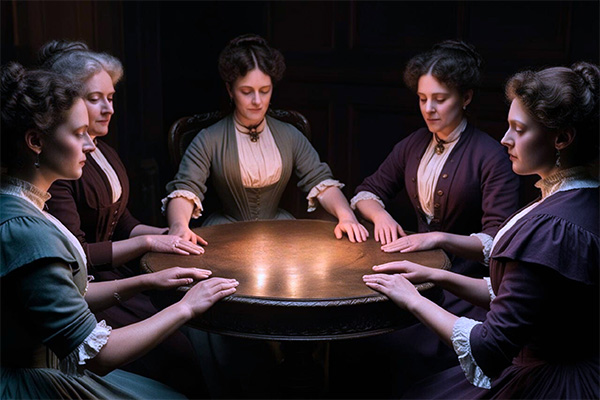mystical phenomena
The Timeless Magic Of Nature Spirits And Elementals
 As a youngster growing up in the UK, I loved visiting a neighbor, Mrs. O’Leary, whose lilting Irish voice still echoes in my mind. She spoke often of the “Good People” and acknowledged their presence in her home and garden. I recall her taking us outside to witness her making small offerings to these unseen little mystical beings.
As a youngster growing up in the UK, I loved visiting a neighbor, Mrs. O’Leary, whose lilting Irish voice still echoes in my mind. She spoke often of the “Good People” and acknowledged their presence in her home and garden. I recall her taking us outside to witness her making small offerings to these unseen little mystical beings.
Though it feels like a distant memory now, I can still recall seeing them, too. Perhaps they appeared to us because we truly believed, or perhaps because Mrs. O’Leary invited them to show themselves.
Whatever the reason, those moments left a lasting impression. To me, it felt like truly being “in my element,” fully connected to the hidden, magical forces of nature.
I vaguely recall a magical moment in Mrs. O’Leary’s garden when she pointed out to me a tiny, translucent little figure perched on a large moss-covered rock at the base of her prized old hawthorn tree. With delight, she described how this “little person” was waving at us and encouraged me to wave back. Standing there with awe and intrigue, I became aware of what seemed like hundreds of luminous sprites dancing in the glistening water below.
Despite all the cynicism of a technologically driven world, increasingly devoid of the many miracles and wonders of nature and the unseen realms, Mrs. O’Leary and the spirits of nature still remind me of the healing, transformative power that lies in reverence, stillness, and everyday magic.
The Mysteries, Messages And Magic Of Meteorites
 Meteorites have long intrigued me as one of the great mysteries of the universe. They’ve fascinated me for years, not only because they survive their fiery descent through Earth’s atmosphere in such an epic and awe-inspiring way, but also because of their extraordinary origins.
Meteorites have long intrigued me as one of the great mysteries of the universe. They’ve fascinated me for years, not only because they survive their fiery descent through Earth’s atmosphere in such an epic and awe-inspiring way, but also because of their extraordinary origins.
Recently, I acquired a small piece of meteorite from Campo del Cielo, a renowned celestial fragment discovered by Spanish explorers in Argentina in 1576. It now graces my altar with it cosmic presence, enhancing the energy of my home and sparking some fun conversations!
Their origins are diverse. Some come from asteroids or comets, others from planetary bodies.
However, what I find especially captivating about these “messengers from space” is that they offer more than just scientific insights into the birth of our solar system.
Even more compelling is the spiritual and esoteric significance they’ve held throughout human history. Across time and tradition, they continue to be revered as powerful allies in spirituality and metaphysics.
Many lithotherapy practitioners believe meteorites are gifts from the divine, reminding us of our eternal connection to the cosmos. They are symbols of spiritual awakening, transformation, and divine wisdom.
Ancient civilizations used them for meditation and healing, to connect with higher realms, and to catalyze personal growth. Because they are quite literally “otherworldly,” meteorites offer us a cosmic perspective and invite us to reflect on our place within the grand tapestry of existence.
The Miracle Gift Of A Reincarnated Pet
 Do animals reincarnate? As an animal lover and pet owner, I believe they do!
Do animals reincarnate? As an animal lover and pet owner, I believe they do!
John Edward, the famous psychic medium, once told how his dog came to him in a dream after he died. Apparently, the dog told him that he would be the new dog “with the black spot.”
Soon after, he went to a friend’s house who had a litter of puppies. He really bonded with one of the puppies – it followed him everywhere. However, none of the puppies had a black spot? Edward’s wife took pictures of him with the puppy because she also felt the connection. They left without taking any of the puppies.
When the film was developed, there was a black spot on one of the photos! The black spot appeared in the picture over the puppy he had such a special connection with. Edward immediately went back and got his beloved “new” dog.
My friend’s dog, Inky, was all white with an unusual dark spot on his back. He also had a strong personality and would follow her on her daily walk to work until she turned and said, “Inky, go home.” When he passed away at a young age, my friend was devastated. I remember her saying that she lay on the floor for days, crying, curled up in a fetal position.
A few months later, she walked by a pet store. There was a bunny in the store that looked exactly like Inky. It was all white, with the same distinctive ink pattern on its back. My friend adopted the rabbit, who also turned out to have the same personality as Inky. He would follow her on her way to work until she said, “Bunny, go home.” Continue reading
The Mystical Experiences Of Twin Siblings
 Twins have long fascinated scientists, spiritual practitioners, and the general public alike, not only because of their identical appearance, but also because of the extraordinary and often mystical experiences they share.
Twins have long fascinated scientists, spiritual practitioners, and the general public alike, not only because of their identical appearance, but also because of the extraordinary and often mystical experiences they share.
These shared experiences raise profound questions about the nature of our existence and the invisible forces that shape our lives.
Whether they grow up apart, but lead remarkably parallel lives, recall past-life connections, share intriguing astrological traits, or engage in telepathic and empathic communication, twins challenge the conventional view that our identities are shaped solely by genetics and environment. Their remarkable similarities suggest that something greater than nature and nurture influences their development and experiences.
The inexplicable bond between twin siblings suggests the presence of unseen influences – forces beyond the material world that govern our existence.
This bond manifests itself in stories of twins who, despite being separated at birth and raised in different environments, end up with strikingly similar tastes, career paths, and life choices. Such coincidences go beyond mere chance and suggest a deeper, more profound connection that transcends the physical realm.
Astrology also offers fascinating insights into the unique connections between twins. Born under the same celestial influences, twins often share similar personality traits and life patterns. Yet even subtle differences in their birth times can lead to slight variations in their astrological charts, adding another layer of complexity to their shared experiences. These astrological nuances can illuminate the dynamics between them and offer a deeper understanding of the forces at play.
A Premonition Dream Could Save Your Life!
 While meditating one afternoon and deep in the alpha state, I heard a clairaudient voice say to me: “You need to get to work because someone needs the message you were given last night.”
While meditating one afternoon and deep in the alpha state, I heard a clairaudient voice say to me: “You need to get to work because someone needs the message you were given last night.”
I wasn’t feeling very social that day and definitely not in the mood to work, but the voice was crystal clear and very insistent.
I mentally asked the voice to show or tell me how and what this message could be? Almost immediately I saw my dream journal in my mind’s eye.
So I stopped the meditation session and went to get my dream journal from my nightstand. I always keep it handy, along with a clip-on night light, so I can record my dreams at any time.
Over the years, I’ve trained myself to recall significant dreams and write down as much as I can remember.
Keeping a dream journal has become incredibly valuable to me personally and in my psychic work. Dreams act as a bridge between the material world and the spirit realm, offering profound insights and guidance.
One of the greatest benefits of dream journaling is the ability to track ‘warning dreams,’ also known as premonition or precognitive dreams. These dreams are forebodings of future events, alerting us to potential dangers, challenges, or negative events that we may soon encounter in waking life.

